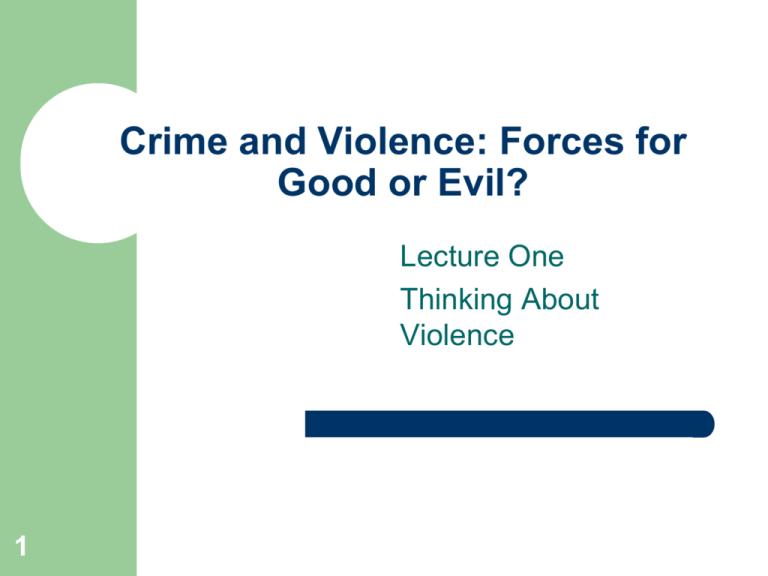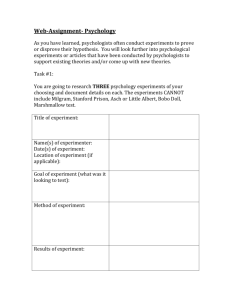lecture one - C-SAP OER project wiki
advertisement

Crime and Violence: Forces for Good or Evil? Lecture One Thinking About Violence 1 Programme Full information on WebCT Lectures 2pm LT1 Dr Helen Jones Seminars Dr Rob Ralphs Dr Hannah Smithson 2 Assignments 3 50% Presentation (proposal due 15th October) 50% E-communication Project (7 week project in Term Two) Considering definitions “the threat, attempt, or use of physical force by one or more persons that results in physical or nonphysical harm to one or more persons” (Weiner, Zahn & Sagi, 1990:xiii) “any act that causes the victim to do something she doesn’t want to do, prevents her from doing something she wants to do, or causes her to be afraid” (Adams cited in Jones, 2000:4). 4 “violence involves the infliction of emotional, psychological, sexual, physical and/or material damage” (Stanko, 1994:xiv). 5 Biological This sees causes of violence as located in the genetic make-up, or chemical imbalances, it is connected with Lombrosian theory which still has some influence today. 6 Psychological Freud would argue it is the impact of childhood that determines adult behaviour. Personal experiences of violence may result in violence. Violent people are often accused of being mad, out of control. 7 Sociological There is a need to examine the social relations of violent individuals and contextualise them in relation to class, race, gender and other social characteristics/divisions. 8 9 People – not all violent people are criminal, consider boxing, rugby, or sadomasochism. We can consider the violent actor but also need to acknowledge the diversity of other subjects – the victim, the judges/magistrates, agencies of support and care, the community. Policies – legislation defines what a violent act is and how the state should respond. Practices – institutional practices – for example, how the police respond, what their attitudes are and how this influences their culture and practices. We also need to consider the influence of primary definers, for example the media. 10 Individual – interpersonal (between people) and intrapersonal (what we do to ourselves). National – State violence, socially located violence (racism, gendered violence, hate crimes). Global – Terrorism, war, torture, corporate crime, trafficking (drugs or people). Stanko argues that there are four crucial elements in considering violence: 11 The act itself The relationship of the participants to each other The location of the act The outcome We should also add: 12 Social rules – because different rules apply in different situations Social roles – because who we are might determine how we act Social power Legal definitions and the law Stephen Jones ‘Understanding violent crime’ pages 5-7. 13 The Home Office definition Violent crime is the generic term for a number of crime types involving physical or verbal assault on a individual. The broad categories are: Violent assault, including incidents of : Racism Homophobia Domestic violence Sexual crimes Robbery 14 Concluding Questions 15 Are there hierarchies of harm? Is murder worse than bullying? Bullying can lead to death. Do we have the right to live free from fear of violence? Is it a basic human right that the state has a responsibility to protect? Are some individuals and social groups more prone to violence and victimisation?








